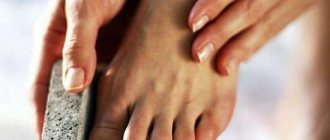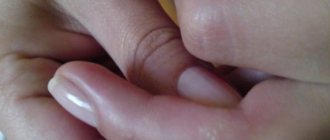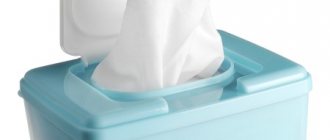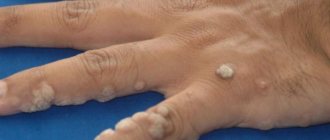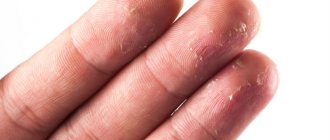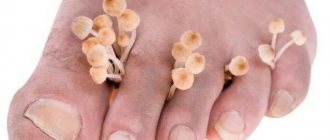Sometimes the appearance of even seemingly minor skin problems may indicate that a malfunction has occurred in the body. In the article we will look at such a symptom as itching between the fingers. What is noteworthy is that such discomfort can appear after contact with chemical irritants, as a result of microtrauma, or be a sign of a developing disease of the internal organs.
Diagnosis of the problem
A dermatologist will help determine the cause and prescribe the correct treatment. In order to have a complete picture of the circumstances under which the rashes began, what preconditions in the form of chronic diseases are in the anamnesis, the doctor interviews the patient. Based on the nature of the rash, its location and accompanying symptoms, the diagnosis is differentiated from other diseases of viral and bacterial etiology.
Additionally, the following tests are prescribed:
- A clinical blood test will indicate the nature of the disease depending on the shift in the leukocyte formula and the predominance of certain blood elements;
- Immunological blood test;
- Analysis of urine. Deviation of indicators from the norm may indicate pathological processes in the body that caused the rash;
- Microscopic and cultural examination of skin flakes for suspected mycosis;
- Bacterial smear examination to identify the causative agent of the disease;
- Histological analysis of the skin is necessary to determine the stage of mycotic dermatitis.
Since a rash between the fingers and on the hands most often occurs as a result of allergic reactions and autoimmune diseases, an additional consultation with an immunologist is prescribed.
Now let's look at the most common diseases, accompanied by a rash and itching between the fingers.
Types of rash
Most often, the rash looks the same; it is very difficult for a non-specialist to determine its type, but in some cases, skin rashes have their own characteristics, which can be used to narrow down the range of possible diseases.
Types of rash on fingers:
- ecthyma - the rash is covered with a crust;
- lupus erythematosus – peeling;
- rashes in the form of pimples;
- bubbles and blisters;
- dry rash;
- vesicle - wet rash;
- macula – change in skin color;
- white rash;
- subcutaneous rash;
- red, inflamed rashes;
- manifestations of herpes infection;
- pustular rash.
Dyshidrotic eczema
Dyshidrosis is a chronic, non-contagious form of eczematous dermatosis, which is characterized by a chronic course.
During relapses, small blisters filled with serous fluid appear on the skin of the palms and fingers. At this phase of dyshidrosis, the patient complains of burning and tingling. As the blisters between the fingers burst, the itching disappears, and at the site of the rash, red spots with a brown base form, the skin is dry and peeling in places.
There are several factors that can trigger the development of the disease:
- Allergic reactions to food and household chemicals;
- Hyperhidrosis – increased sweating of the hands, which can cause diaper rash between the fingers;
- History of atopy;
- Thyroid diseases;
- Problems with the gastrointestinal tract;
- Stress, nervous breakdowns, severe shocks.
During exacerbations, you should follow a diet that excludes food allergens, as well as foods that irritate the mucous membrane. Contact with cosmetics and detergents should be kept to a minimum; gloves should be worn when using household chemicals.
It is impossible to cure dyshidrotic eczema; to reduce the manifestations of the disease, the following remedies are used:
- Antihistamines;
- Local hormonal ointments to relieve itching;
- Compresses with Burov's solution;
- Ultraviolet-A irradiation;
- Baths with a decoction of oak or oat bark.
Important: the use of hormonal ointments and corticosteroids is possible only as prescribed by a doctor. You should also not extend the course of treatment or increase the dosage on your own.
Prevention
To prevent the disease, it is necessary to take basic preventive measures:
- Before contacting with household detergents, you should always use protective gloves.
- For cold allergies, it is recommended to keep your hands warm and spend less time outside. When weather conditions change, you should use special creams with an increased protective factor.
- Habitual shampoos and cosmetics must be replaced with hypoallergenic products, as they soften the skin on the fingers well, moisturizing it and preventing the development of negative manifestations.
- One of the main conditions for preventing allergic manifestations is following a special diet that excludes eating foods that provoke negative symptoms. It is necessary to exclude exotic fruits, coffee, chocolate, strawberries, some types of meat, etc. from the diet.
It is recommended to consume a large amount of fiber, which is contained in fresh vegetables and fruits. In addition, with regular use of a complex of vitamins, the risk of developing allergies is reduced several times.
Hyperkeratotic eczema
A chronic disease of unknown etiology, it occurs more often in women during menopause, which suggests the presence of a hormonal factor in the development of dermatitis.
It appears on the inner surface of the palms and fingers in the form of dense, keratinized scales that adhere to the skin.
Irritation, cracks between the fingers, itching and burning of moderate intensity are noted.
For hyperkeratotic eczema the following is prescribed:
- Keratolytic ointments based on 10% emollient in combination with salicylic acid;
- Topical steroids;
- For internal use Etritinate in a dosage of 25 or 50 mg, depending on body weight and severity of the disease.
Dryness and peeling of the skin in the remission phase are eliminated with moisturizing emulsions with D-panthenol and vitamins A, E. Wounds and cracks during an exacerbation are treated with antiseptic solutions of Furacilin.
Types of skin rashes on the hands
Any rash on the skin causes a lot of inconvenience to a person, especially if it appears on the hands.
I want to hide the affected areas from prying eyes, but this will not solve the problem. Almost all diseases to one degree or another affect the human skin.
Dysfunction of internal organs manifests itself on human skin in the form of rashes. They have a different nature of formation, appearance and duration of manifestation.
Skin rashes are divided into primary, which form on the body, and secondary. They appear again in places where the skin has just cleared of the initial manifestations. Based on external signs, rashes are divided into several types.
- Bubbles. In medicine, the formation of bubbles on the body, which are filled with a clear liquid inside, is called a vesicle. They can be single or consist of several compartments. The size of the bubbles does not exceed a centimeter. Opening such formations sometimes leads to the formation of ulcers and erosions.
- Pustules or pustules. The rash looks like a vesicle, which is filled with pus inside. Such formations can be superficial, deep and follicular.
- Nodule or papule. Manifestations are expressed by a change in skin color.
- Blister. A similar formation on the skin has a pinkish color. The resulting blisters may disappear on their own after some time, without the use of medications, and the skin returns to its previous appearance.
- Spot. The manifestation is not expressed by swelling. It is different in color and is flush with the skin.
Dermatitis
Diseases belonging to the group of dermatitis are characterized by inflammatory reactions on the skin, accompanied by an increase in temperature in the affected areas and rashes. These can be various elements of the rash:
- Papules;
- Dense tubercles;
- Pimples;
- Pustules (pustules);
- Bubbles filled with serous fluid (vesicles);
- Blisters.
Such skin reactions occur in the presence of external or internal irritants. In rare cases, the rash on the hands and between the fingers is of an autoimmune nature.
Causes of finger allergies
- Allergies between the fingers most often occur during close contact with household cleaning products that contain chemicals.
- In addition to the allergic effects of chemical elements, the cause of increased sensitivity on the hands can be a genetic predisposition, negative weather conditions (rain, wind, cold).
- In addition, allergic symptoms can be triggered by a stressful situation, direct contact with soil and water, increased sweating, etc.
Types of Dermatitis
Dermatitis localized to the hands, palms and between the fingers can be classified according to the causes of the skin reaction.
- Contact. A temporary allergic skin reaction that occurs upon contact with an external irritant. These could be: cosmetics; household chemicals; synthetic fabrics; nickel, copper and other metals used in the manufacture of jewelry; latex gloves; chemicals contained in nail extension and coating materials; biological irritants - pollen or plant sap, animal hair.
- Cold . The cause of inflammation is capillary spasm when exposed to low temperatures.
- Actinic . Atypical reaction to various types of radiation .
- Taxidermy . Occurs when an irritating substance enters the body - medications, food allergens, fumes of harmful substances.
- Atopic dermatitis is a genetically determined type of disease, complicated by nervous stress and diseases of the internal organs.
- Traumatic . Irritation of the skin of the hands, periodically occurring due to friction, burns or frostbite.
Factors that provoke the development of dermatitis can be: stress, severe illnesses, antibiotic treatment, diseases of the endocrine system and disruption of intestinal microflora.
General principles of treatment
An important component of successful treatment is the correct diagnosis and identification of the cause of dermatitis.
Eliminating the allergen or avoiding contact with it helps reduce the manifestations of the rash and alleviates the patient’s condition. During the acute course of the disease, you should follow a hypoallergenic diet, and also avoid products that contain dyes, preservatives and flavor enhancers.
It is not advisable to abuse fatty, smoked, salty foods and sweets.
First steps when itching appears
Often this itching is accompanied by local redness of the skin, the appearance of a rash or blisters. In this situation, the help of a specialist is required. A dermatologist will determine the causes of this condition and prescribe adequate therapy. Treatment tactics will be directly related to the factor that provokes itching.
If the skin around your fingers is very itchy, there are a number of actions you can take to reduce the intensity of the symptom.
- Severe itching can be relieved with cold compresses. It is enough to wrap an ice cube in a cloth and apply it to the surface of the skin.
- Oatmeal solution has a similar effect. To prepare it, the flakes are poured with hot water, then cooled and the affected limbs are immersed in the liquid.
- If the skin on your hands is flaky and itchy, you should not use hot water. This may cause additional irritation.
- Contact with caustic substances and household chemicals must be avoided. It is best to carry out household work with gloves.
- You should also avoid using any hand cosmetics.
All these measures will prevent the situation from getting worse. After relief of the condition, you need to consult a dermatologist.
Treatment due to fungus
In the initial stages of mycosis, or infection of the skin surface by a fungus, the manifestation occurs with mild itching and redness. Over time, peeling develops and bleeding cracks form. An accurate diagnosis is established after receiving test results.
The treatment regimen for mycosis will depend on the stage of the disease and the intensity of the symptoms. To relieve them, topical medications are prescribed:
- ointments;
- sprays;
- cream;
- gels.
Exoderil ointment has good reviews. The product should be applied once a day for a long period. The exact duration of the course will be determined by the doctor. Other drugs, for example, Nizoral, Lamisil, Zalain, effectively destroy the mycelium of the fungus.
Additionally, you can use zinc paste or salicylic ointment. These are safe but effective remedies. They are used even in childhood, as well as during pregnancy.
If there is fungus on the skin between the fingers, the dermatologist will recommend medicinal baths. You can use baking soda or potassium permanganate. Soda creates an alkaline reaction of the environment, which is detrimental to fungus, and a solution of potassium permanganate accelerates skin regeneration processes.
Candidiasis between fingers
The causative agent of this skin disease is fungi of the genus Candida, which are part of the natural microflora of humans, but in such small quantities that they cannot cause harm or cause irritation.
The cause of the growth of a fungal culture can be various factors:
- Hormonal imbalances;
- Stress;
- Weakening of skin immunity;
- Long-term use of hormonal creams.
Interdigital candidiasis manifests itself by the appearance of single vesicles that do not bother the patient. Next, the area of skin affected by the fungi becomes swollen and becomes covered with a white coating.
During treatment, the patient is prescribed local medications, such as:
- Clotrimazole;
- Fluconazole;
- Lamisil.
You should also follow a diet limiting the consumption of sugar and fatty foods.
Treatment of various types of skin diseases involves the prescription of drugs, the effects of which may be fundamentally different from each other. Thus, antibiotics and corticosteroids are not used for viral and fungal infections, and antihistamines can aggravate scabies.
For this reason, at the first alarming symptoms, such as rash, itching or redness, you should consult a doctor for a diagnosis.
Treatment for scabies mites
If the skin between your fingers is very itchy, the presence of subcutaneous parasites cannot be ruled out. One of them is the scabies mite. The itching is caused by his bites. Females gnaw passages in the subcutaneous space and lay eggs there.
Itching of the hands between the fingers is treated only after a tick is detected. Therapy will continue for 2 weeks. This is necessary to destroy the entire parasite population. Typically, benzyl benzoate-based products are prescribed.
The ointment is applied directly to the skin between the fingers. The disadvantage of such products is their high toxicity. Sulfur ointment effectively relieves itching; it is an inexpensive remedy that is available in every pharmacy.
Spregal is an anti-scabies agent in aerosol form. Ticks die after a single treatment, but symptoms may persist for a week. During treatment, bedding and clothing of all family members should also be treated. This will avoid re-infection.
To treat scabies, water-soap solutions and oil emulsions with benzyl benzoate and the addition of anesthesin are used. When used for the first time, such external preparations cause the death of all parasites that are in the active stage.
To eliminate mite larvae, the skin is re-treated on the fourth day of treatment. The disadvantage of this drug is its aggressive effect on the dermis, which is manifested by dryness and irritation of already injured skin.
Preparations based on pyrethrins (Permantrin) do not have a toxic effect, and also eliminate both larvae and adults with a single use. No less effective is Spregal spray, which is prescribed for extensive localization of ticks on the surface of the body.
Outdated methods of combating scabies include sulfur ointment, Lindane and Crotamion (Yurax) due to side effects, including neurotoxic effects, erythema, conjunctivitis, and complications of kidney function.
Folk remedies
To alleviate the patient’s condition (eliminate itching, relieve inflammation and return the skin to its former healthy appearance), you can use traditional medicine. However, one must understand that using folk remedies alone is not advisable to influence the cause of the pathology; treatment of a rash on the hands should be based on searching for the cause and traditional treatment. Folk remedies can be used as symptomatic treatment in addition to the main one.
- Motherwort infusion. You will need a glass of boiling water and a tablespoon of dry plant material. Leave for an hour, strain, drink throughout the day.
- Infusion of birch buds. You will need a tablespoon of dry buds and 5 tablespoons of vodka. The buds need to be ground and filled with vodka. Leave for a week and then use to treat affected areas of the skin.
- 20 grams of St. John's wort is poured into 0.5 liters of vodka. After a week, the tincture is filtered and used to treat the skin.
- Grind fresh cucumbers. Pour a tablespoon of gruel into a glass of boiling water, leave for 2 hours, then strain, add a teaspoon of honey. The resulting product can be used to treat not only rashes on the hands, but also acne on the face.
- It is also recommended to take strengthening vitamin preparations. For example, take 10 g of Chinese lemongrass berries, 5 g of elecampane root, 10 g of sage. Mix everything well, pour a tablespoon of the mixture with a glass of water. Boil for 10 minutes, leave, drink chilled with the addition of cinnamon.
Treatment of eczema
Eczema is an inflammatory disease. In addition to itching, a rash and swelling are observed. Interdigital eczema is one of the most unpleasant forms. Cracks and blisters form on the skin. The affected area becomes wet and itchy. Treatment is usually long-term. Its success depends on the stage of the disease at which the medication was started.
The best effect is with hormonal ointments. Dermatologists often prescribe medications such as:
- Hydrocortisone ointment.
- Dermazin.
- Prednisolone.
- Advantan.
- Dermovate.
Of the non-hormonal products, Elidel cream is the most effective. With its help, you can not only eliminate discomfort, but also prevent the development of infection.
If the skin lesions are extensive, accompanied by severe itching, then complex therapy will be required. Local remedies will not be enough. In such cases, doctors usually prescribe:
- antibiotics;
- antihistamines;
- sorbents;
- sedatives;
- vitamins.
Hand baths with baking soda are indicated as auxiliary measures to the main treatment. This substance perfectly relieves itching and reduces swelling. For this purpose, you can use decoctions of herbs, for example, string or plantain.
Why do acne appear?
Although fungi are opportunistic for people, they cause a lot of trouble for both children and adults. There can be many reasons why pimples occur. The fungus can get on the mucous membrane and spread throughout the body, but remain silent for a long time. Whether a child will catch it depends on the general state of health and the strength of the immune system. And given how children like to put everything in their mouths, the risk of infection increases. In addition, some diseases provoke easier development of the fungus, including:
- Metabolic disorders, especially diabetes, obesity.
- Gastrointestinal diseases.
- Severe pathologies, such as cancer.
- Imbalance of vitamins in the body.
- Operations on internal organs.
- Use of a specific group of medications.
Pimples on the hands can also be chickenpox, but apart from the fingers they will appear all over the body, the spread is rapid, they itch very much. The causes can also be insect bites and not only mosquitoes, but also bedbugs.
Treatment due to psoriasis
Psoriasis often affects the skin between the toes. In this case, inflamed areas of red or pink color appear. The skin begins to peel and itch.
For psoriasis, topical medications are prescribed to quickly relieve symptoms. These can be hormonal ointments, for example: Advantan or Celestoderm. In some cases, non-steroidal drugs are sufficient. The most common of them are Psoriaten, zinc paste, Vishnevsky ointment.
You will also need to take antihistamines in the form of tablets, immune-strengthening agents and vitamin complexes.
To get rid of itching between the fingers with psoriasis, you must adhere to a special diet. It is worth excluding citrus fruits, chocolate, milk, and honey from your diet. The consumption of foods with red pigment should be minimized.
Medicines for itching
Drug treatment consists of the use of local and systemic drugs.
- Antihistamines : Fenistil, Claritin, L-cet, Zodak. They reduce the activity of the immune reaction and block the production of the inflammatory mediator – histamine.
- Sedatives : Novo-passit, Notta, Tenoten, Fitoset. Normalize the functioning of the nervous system, relieve stress and tension, eliminate anxiety. Such drugs are prescribed for atopic dermatitis.
- Non-hormonal ointments with complex effects have anti-inflammatory, healing and antibacterial effects. The list of the most effective: Radevit, Fenistil gel, Protopic, La-Cream, Eplan, Losterin.
- Hormonal preparations for external use have an anti-inflammatory effect. By blocking the activity of mast cells, steroids relieve swelling, reduce itching and redness of the skin. Ointments and gels contain one of the following active ingredients: hydrocortisone, betimethasone, flumethasone, mometasone or clobetasol. Long-term use of hormonal creams can cause dry skin and disruption of the adrenal cortex.
- Regenerating creams and emulsions that are used during the healing stage.
Wounds and cracks on damaged skin of the hands are gateways for bacteria, and the use of hormonal drugs can provoke the growth of fungi, which are present in small quantities on the skin as a component of the natural microflora. To prevent secondary infections and prevent fungus between the fingers, you should adhere to hygiene and use antiseptic solutions.
Rashes in children
A rash on a child’s fingers is a fairly common phenomenon; most often its appearance is associated with poor hygiene, however, there may be other reasons:
The clinical picture of a rash in a child can be varied. In some cases, the temperature may rise, the child is constantly itching and becomes restless.
It is very important to ensure that the child does not scratch his hands, since this can cause a secondary infection and the child’s condition will worsen.
Treatment due to allergies
Allergic reactions can occur in response to various irritants. Most often these are household chemicals, washing powders, and cosmetics. Itchy hands between the fingers may be the result of a food allergy or a side effect of medications. Treatment in this case begins with eliminating the provoking factor.
To select medications, you should consult an allergist and dermatologist. Treatment is usually complex. Antihistamines are required. Well proven:
- Zyrtec,
- Suprastin,
- Tsetrin,
- Claritin.
If itching on the skin is caused by a reaction to foods, then you will additionally need to take sorbents, for example, activated carbon. You can opt for drugs such as Smecta or Enterosgel.
Steroid-based ointments will help eliminate itching as quickly as possible. They should be applied daily directly to the affected areas of the skin.
Treatment of itching between the fingers is carried out under the supervision of doctors . It is not recommended to select medications on your own without finding out the cause of the discomfort - this can aggravate the situation.
The disease can become chronic, and itching will become a permanent symptom. If the medications are selected correctly and all the dermatologist’s recommendations are followed, the itching quickly subsides and ceases to bother you.
